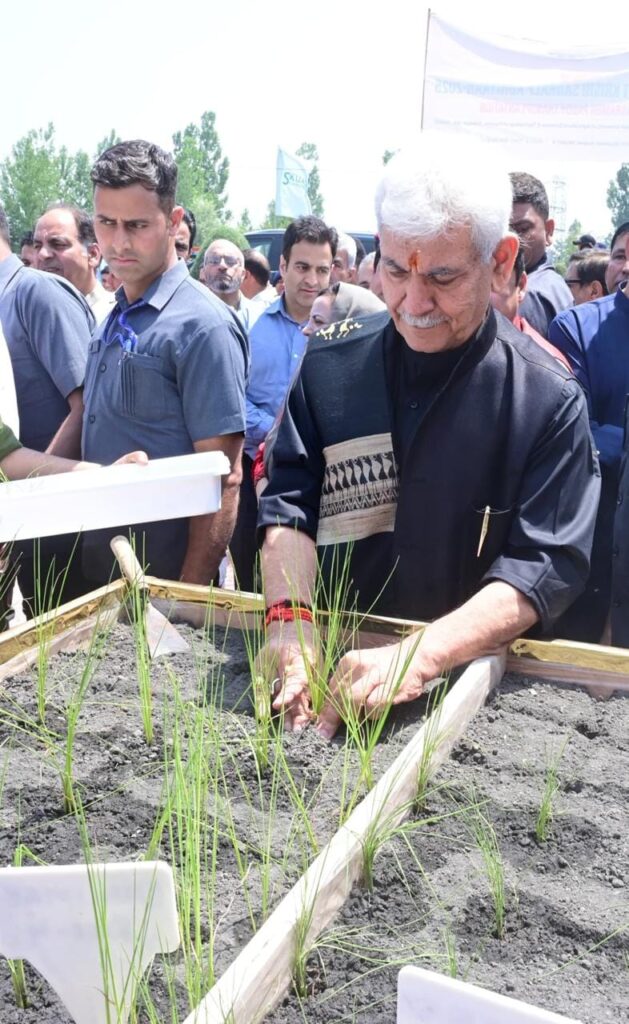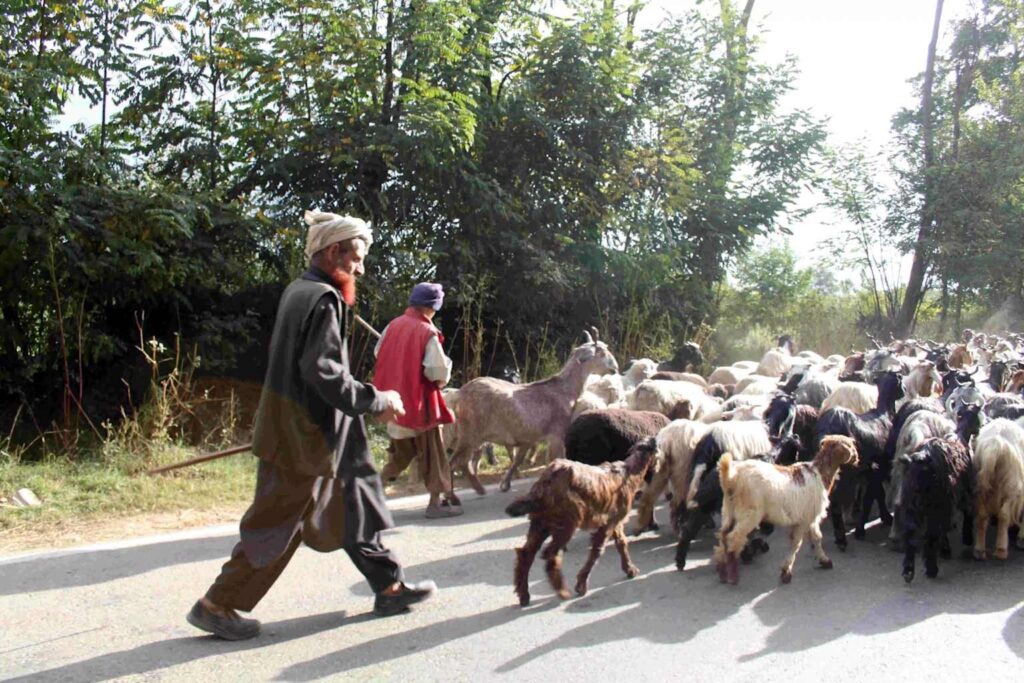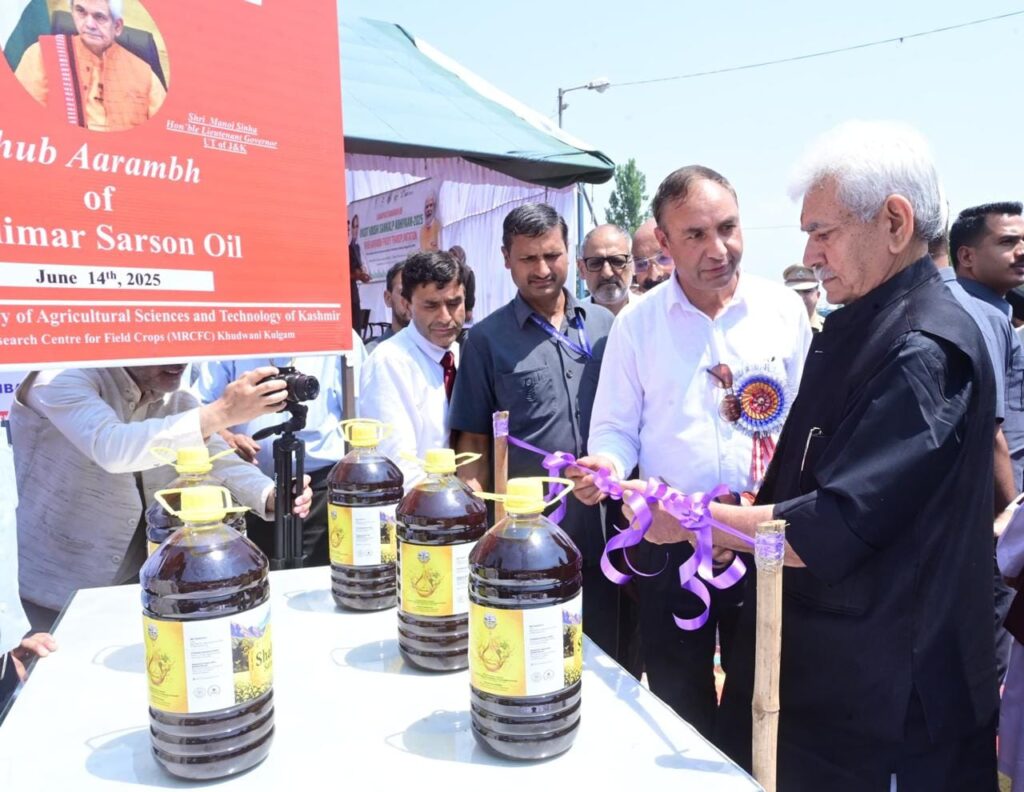By Ajaz Rashid
In a significant address that underscored the evolving political dynamics in Jammu and Kashmir, Lieutenant Governor Manoj Sinha described the boundaries of administrative responsibility while unveiling ambitious agricultural targets for the Union Territory. Speaking at the closing ceremony of the Viksit Krishi Sankalp Abhiyan in Kulgam, Sinha emphasized that while security remains his primary domain, developmental initiatives now rest with the democratically elected government. The announcement comes as J&K pursues an unprecedented ₹1 trillion agricultural economy by 2030, positioning the region as a cornerstone of India’s Viksit Bharat vision for 2047.
Political Governance Realignment in Post-Article 370 Kashmir
The Lieutenant Governor’s candid remarks to Education and Social Welfare Minister Sakina Itoo revealed the transformed governance structure in Jammu and Kashmir following the restoration of democratic institutions. When Itoo appealed for greater government support and new agricultural policies, Sinha’s response was unambiguous: “All I can offer is ‘security’—everything else, from roads and electricity to water and agriculture, now lies with the elected government”. This statement marked a clear demarcation of responsibilities between the constitutional head and the elected administration led by Chief Minister Omar Abdullah.
The governance transition represents a significant shift from the period of direct central administration that followed the abrogation of Article 370 in August 2019. The National Conference-Congress alliance’s victory in the 2024 assembly elections, securing 49 seats out of 90, established the first elected government in the Union Territory. Omar Abdullah, who assumed office as Chief Minister on October 16, 2024, became the first to hold this position after the revocation of Kashmir’s special status.
This political realignment has created a unique administrative structure where security affairs remain under the Lieutenant Governor’s purview while developmental responsibilities have been transferred to the elected government. The arrangement reflects the constitutional framework established for the Union Territory, balancing democratic governance with strategic security considerations.

Holistic Agriculture Development Programme
J&K had launched similar initiative in 2022 through Holistic Agriculture Development Program (HADP), the first revolutionary program in agriculture in any state or UT in recent times. It is a comprehensive strategy, designed to make J&K UT a robust RS. 1 trillion agricultural economy by 2030, he said.
HADP represents a comprehensive approach to agricultural development that extends far beyond traditional farming practices. The program includes initiatives spanning seed production, precision farming of vegetables, bee-rearing, cocoon production, mushroom farming, organic agriculture, high-density fruit farming, processing, dairying, sheep and poultry farming, and fodder production. This holistic framework aims to transform the agricultural economy by promoting sustainability and commercial viability while ensuring farmer prosperity and rural livelihood security.
The program’s impact has been substantial across multiple sectors. “We were not content with piece-meal reforms. From oilseeds to livestock, from milk to pulses, every sector has been addressed through a comprehensive model,” the LG said. “Mustard cultivation, which was on just 400 hectares in the Valley in 2021, now covers over 5,000 hectares. This isn’t just about oil; it supports fodder, beekeeping, and soil health too.”The mustard crop has registered a staggering increase of over 250 percent in the area coverage and emerged as a beacon of hope, steering the Kashmir Valley towards transforming livelihoods, fostering economic growth and reducing dependency on imports.
Agricultural Achievements and Statistical Progress
The implementation of HADP and related initiatives has yielded impressive results across various agricultural sectors in Jammu and Kashmir. The programme’s comprehensive approach has generated measurable improvements in production capacity, farmer engagement, and market integration.
In the livestock sector, milk-processing capacity has increased six fold under HADP, while fish production has risen by 33% and prawn production has doubled. These improvements reflect the programme’s emphasis on diversifying agricultural activities beyond traditional crop production. Cold storage capacity in the Union Territory has more than doubled since 2020, addressing critical infrastructure needs for agricultural value chains.
The research and development component has been equally impressive, with SKUAST Kashmir developing 20 new rice varieties specifically suited to Kashmir’s climate conditions. The establishment of the Shalimar Seed Company represents a “game-changer” for regional farmers, ensuring sustained availability of high-quality seeds developed by SKAUST-K.
Market integration has progressed significantly through the electronic National Agricultural Market (e-NAM) platform, with 17 mandis now connected to the system, facilitating trade worth over ₹1,050 crore. This digital transformation has enhanced market access for farmers while improving price discovery and reducing transaction costs.

Farmer Engagement and Community Outreach
The Viksit Krishi Sankalp Abhiyan, which concluded in Jammu and Kashmir with a two-day extension due to Eid celebrations, demonstrated the scale of direct farmer engagement in the region. During the campaign, officials directly interacted with over 2.8 lakh farmers across 4,500 villages, promoting sustainable and profitable farming practices.
The campaign’s reach extended beyond mere numbers, focusing on inclusive development that encompasses marginalized communities. Special attention has been given to tribal farming communities, including Gujjars, Bakarwals, and Paharis, who serve as custodians of forests, mountains, and traditional wisdom. Land rights have been granted to these communities, integrating them into formal agricultural development frameworks.
Women’s participation in agriculture has seen remarkable growth, with 4.69 lakh women connected to integrated farming and livestock management initiatives. This engagement has led to the creation of over 225,000 agri-nutrition gardens and 40 integrated farming clusters, demonstrating the programme’s success in promoting inclusive agricultural development.
The participatory governance approach emphasized by Lieutenant Governor Sinha reflects a shift from top-down policy formulation to field-based dialogue with farmers. “Policies should not be made in secretariats alone. They must be forged in fields, in dialogue with farmers. The connection from lab to land and from seed to market is what drives real change,” Sinha stated.
Strategic Vision for 2030 and Beyond
Jammu and Kashmir’s agricultural transformation is anchored in a clear strategic vision that extends to 2047, aligning with India’s broader development goals. The immediate target of achieving a ₹1 trillion agricultural economy by 2030 represents a doubling of the current agri-sector GDP from approximately ₹50,000 crore.
This ambitious target is supported by comprehensive planning that addresses multiple dimensions of agricultural development. The approach recognizes agriculture as the “backbone of self-reliance” and positions J&K farmers as stakeholders in India’s journey towards becoming a Viksit Bharat by 2047. The vision encompasses not merely production increases but fundamental transformation of agricultural practices, market integration, and farmer prosperity.
The integration with national initiatives like the Viksit Krishi Sankalp Abhiyan demonstrates how regional programmes align with national development strategies. The campaign, launched nationally on May 29, 2025, aims to modernize Indian agriculture through scientific outreach, sustainable practices, and farmer empowerment.
Jammu and Kashmir’s agricultural renaissance marks a turning point in its post-2019 development journey. With an ambitious goal of building a ₹1 trillion agri-economy by 2030, backed by the Holistic Agriculture Development Programme (HADP), the region is positioning itself as a model of rural transformation.
The governance approach—clearly outlining roles between the Lieutenant Governor’s office and the elected leadership—has created a space for cooperative administration while ensuring strategic oversight. Programs like the Viksit Krishi Sankalp Abhiyan and HADP are already showing on-ground results, proving that this framework can deliver.
What makes this transformation particularly notable is its inclusivity. From traditional farming families and women cultivators to the use of cutting-edge technology, every element is being brought together to shape a more equitable and sustainable agri-future. As LG Manoj Sinha aptly put it, “Let every field bloom with prosperity, every farmer thrive with dignity, and every village become a symbol of development.”
The road ahead demands persistent focus on both development and stability. Only through ongoing collaboration between government, institutions, and the farming community can this momentum be sustained—making Jammu and Kashmir a vital contributor to India’s vision of becoming a developed nation by 2047.

